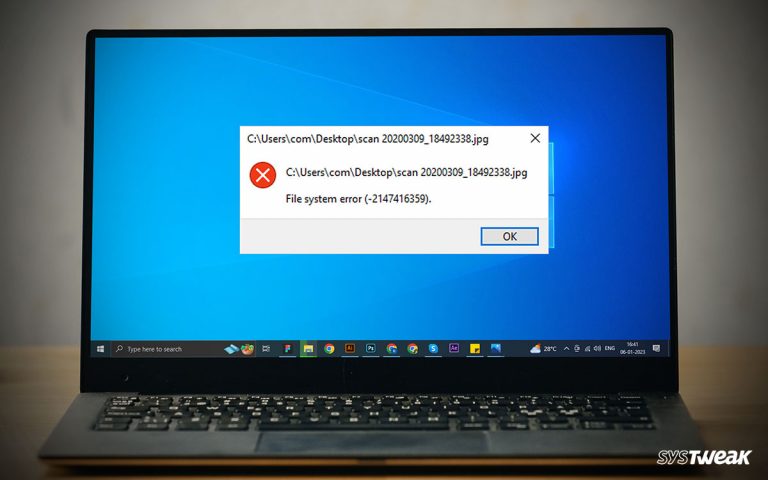System files are important to keep the Windows PC running. You can back up and restore them using built-in ways and third-party software. Here’s a detailed guide on backing up and restoring system files.
50% OFF

BLACK FRIDAY OFFERS
Unlock Black Friday Mega Savings — Systweak Tools FLAT 50% OFF!
There are tens of thousands of files on Windows, but not all are equally important. Some are critical as they help Windows and its various components function properly, while others aren’t. That’s why learning how to keep these files safe is important. So what are these files, where can we find them, and how can we keep their backup? Is there a tool for it?
Let’s find out.
If you have no time to read the complete post, try System Files Backup and Restore feature offered by Advanced System Optimizer.

Coming back to the point, let’s start with what system files are.
What are System Files on Windows?
Files necessary for the Windows operating system to process apps and device drivers are called system files. Without them, the apps crash, certain processes show errors, and sometimes hardware stops working. Therefore, keeping a backup of all system files is vital.
Kernel32.dll is a common example of a system file; its primary function is managing memory. Simply put, the file ensures Windows has enough memory to operate the processes and apps. When the Kernel32.dll get corrupted, due to any reason, you can face all sorts of memory-related issues on Windows.

Different File Extensions of System Files
- SYS
- DLL
- CAB
- MSI
- LNK
- DMP
- TMP
- INI
- ICO
Where are System Files Saved on Windows?
The system files are mostly stored on the local drive (C:) in System 32 (for 32-bit systems) or SysWow64 (for 64-bit systems) folder.
The path is This PC > Local Disk (C:) > Windows > System32 or SysWOW64.

Why Is It Important To Keep A Backup of System Files?
For any operating system to perform, System Files are required. These files, if corrupted, can make the system nonfunctional. Therefore, a copy of system files should be kept.
There are instances when the installation and uninstallation of software cause harm to the system. In such a scenario, you can restore the system using the system file backup.
How do You Back up System Files?
System files can be backed up using a third-party tool and the built-in Backup feature. Here we explain both ways. You can pick the one that suits your needs. However, if you are looking for a quick and simple way, use the System Files Backup and Restore feature offered by Advanced System Optimizer. Click here to jump to the section.
Method 1 – Backup and Restore Files in Windows 10 Through File History
To use the File History option on Windows 10, you will first need to set it up. For that, you need to connect a backup device. To do so, press Windows + I to open Windows Settings > Update & Security > Backup > and click Add a drive. Select the location where you want to save backups.

This will enable File History. You can now set up a few parameters by clicking More Options.
Click the drop-down menu under Back up my files and select how frequently you want to back up your files. Also, you can decide the duration for which you want to keep the files.

File History will now start keeping a backup of Desktop, Downloads, Music, etc. Remove it from the list if you do not want to back up a particular folder.
Please scroll down the Backup Options, review the list > select the folder to delete, and choose Remove to exclude it.

If you want to add any other folder, click the Add a folder under Back up these folders. To exclude specific folders, look for Exclude these folders > click Add a folder and add the folder to exclude.

Once you are done with the settings, click Back up now. Windows will start the backup process, and once it is done, you will see the size, date, and time of the backup created.

Note – You can change the backup destination whenever you want. Open Backup > More Options > Stop using Drive.

Method 2 – Using Advanced System Optimizer’s System Files Backup and Restore Feature
In the present scenario, backup and restoring Windows 10 system files is inevitable. For a layman, tracking down the system files and managing a backup of each file is not easy. Moreover, keeping Windows 10 file backup is a tedious & time-consuming task. But, using System Files Backup and Restore, users can easily identify the system files and take the backup of Windows 10 and other essential files in an organized manner.

The System Files Backup and Restore module offered by Advanced System Optimizer takes the complete backup of all system files needed for Windows to operate. Also, it facilitates easy restoration options in case of system failures. Furthermore, it has additional features that assist in importing backups taken previously or backups taken by other users to its own Backup List.
Download and Install Advanced System Optimizer on Your PC.
How To Use System Files Backup and Restore?
The complete System Files Backup and Restore is summarized with a very simple user interface and the three tabs in the application. The “Backup” tab helps in taking a complete backup of system files, while the “Restore” tab is there to support the restore activity, and the “Import Backups” helps upload system backups taken previously.

Backup Tab
System Files Backup and Restore takes the backup of all system files in three easy steps (see left panel):

1). Welcome
2). Backup Progress
3). Finish
Step1: Welcome
The welcome screen shows a button “Take Backup Now” in the middle of the screen that specifies the action in itself. By clicking this button, the system files backup process is initiated.
The lower half of the screen displays the System Summary –
- Date of Last Backup and
- of existing backups
Clicking “Take Backup Now” opens a new window asking where to save the backup. To select a suitable location, click on the icon in the right-hand corner of the box and browse through Windows Explorer.

After that, press the “Start Backup” button. System Files Backup and Restore will start Windows 10 file backup. If you want to stop the process, click the “Cancel” button. This will discontinue the process and take you back to the Welcome screen.
Step2: Backup Progress

System Files Backup and Restore will now take the complete backup of all system files. The system might slow down while taking the system file backup, but there’s nothing to worry about. Since the system is in use, this happens sometimes. Therefore, we recommend backup Windows 10 files (system files) when the system is idle.
Step3: Finish
Backup Summary

The last step shows the successful completion of the system file backup. Here, the displayed information shows – Backup time and Backup Location.
You may click on the “Finish” button to restart the process.
Restore Tab

In case of system failures or malware infection, or problems caused due to improper software uninstallation using the Restore tab, the backups taken can be put back
The system can be restored to the last best configuration known in three easy steps (see left panel):
1). Welcome
2). Restore Progress
3). Finish
Step1: Welcome
Restoring System Files
The Welcome screen shows a “Restore Backup,” a button clicking on, which helps view the Backup List. This list consists of all the backups taken so far, with the date, time, and path to which the backups are stored.
You can select any backup that you consider suitable from the list and restore the system to that configuration by clicking on the “Start Restore” button.


Note: If you think some backups are too old, remove them from the Backup List by clicking the “Delete” button. Clicking the “Cancel” button helps you return to the previous screen.
Step2: Restore Progress

Restoring the selected backup system requires restarting; you will see this message. Click “Yes” to continue.
Step3: Finish
After the system restarts, your system will be restored.
Read Also: Best PC Cleaner Software for Windows
How To Import Backup?
You can use this section if the Backup List in System Files Backup and Restore does not contain the system backups taken.

Explanation: When system backups are taken using some other applications, these backups might not be seen under System Files Backup and Restore. But using this option, these backups can be imported.
Note : One should be careful while restoring these imported backups. Some backups might take you to unhealthy system configurations that may be fatal for the system. In extreme situations, the operating system may have to be reinstalled. Therefore, when importing and restoring a backup, be very careful.

This operation is divided into 2 steps (see left panel):
1). Welcome
2). Finish
Step1: Welcome
Restore the Previous Backup
System Files Backup and Restore assists in adding the previously taken backups on the same system to the existing Backup List. For this purpose, click on the “Restore Previous Backup” button.

After that, select the location where backups have been stored > and click on the “Start” button.

You can see the import progress in the lower half of the screen.
During the import process, two cases might encounter.
1). If the backup to be imported already exists in the Backup List, it will not be imported.
2). If the backup to be imported does not exist in the Backup List, it will be imported and added.
Once backups are imported to the Backup List, these can be restored if necessary. But this should be done with full caution. Restoring unknown backups may prove fatal because Windows must be installed again.
Step2: Finish
Import Backup Summary
After successfully importing backups, the import summary shows the Import Details and Import Location.
To return to the Welcome screen, click the “Finish” button and repeat the process.
Writer’s Tip – Take Backup on Windows 11
If you are a Windows 11 user, then also using Advanced System Optimizer, you can take a backup. However, if you want to use the File History option follow these steps:
- Press Windows + S and type Control Panel in the search field.
- Look for the File History option in the Control Panel. If you are unable to find it change the view to Icon

- Connect the drive > and enable File History to start taking backups.

You can use the Select drive option to change the drive at any time. Also, you can customize settings from the Advanced settings option.
Backup and Restore System File With Ease
This is it; you can back up and restore your Windows 10 file backup using these simple steps. We hope you find the information helpful and will try backing up your system files. If you have any questions about this or the product, please get in touch with our support team at support@systweak.com.
Also, share your feedback in the comments section.
Recommended-
- How To Identify and Remove Bloatware?
- How to Uninstall OneDrive on Windows 10 – OneDrive Uninstaller
- Windows 11 Keeps Crashing? How To Fix It
- How to Free Up Space in Windows 11,10






One thought on “How To Backup & Restore Windows 10 System Files”